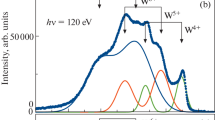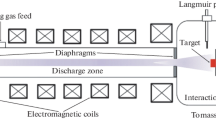Abstract
THE adsorption of water on tungsten and its subsequent desorption have been studied using the technique of field emission microscopy1. The field emission patterns obtained from a tungsten cathode at a pressure of water equal to 4 × 10−9 mm. are shown in Figs. 1 and 2. The times given are those for which the tip was exposed to water vapour after a 2-min. flash at 2,500° K. These patterns are quite different from those obtained during the adsorption of either hydrogen or oxygen on tungsten2. In Fig. 1, the central 011 plane appears to be strongly emitting, in contrast to oxygen adsorption when it remains dark for at least 20 min. at this pressure. Closer inspection reveals that the strongest emission is actually from the region immediately surrounding this plane. After prolonged exposure to water (Fig. 2), the 012 region is very dark and the main emission is from the 111 region. The abrupt change in work function in crossing a line drawn diagonally from the central 011 plane and just missing the 112 plane is most remarkable.
Similar content being viewed by others
References
Muller, E. W., Ergebn. Exakt. Naturwiss., 27, 290 (1953).
Jacobs, P. W. M., Lodge, G. W., and Tompkins, F. C. (to be published).
Author information
Authors and Affiliations
Rights and permissions
About this article
Cite this article
HILL, R., JACOBS, P. Adsorption of Water on Tungsten. Nature 180, 1117–1118 (1957). https://doi.org/10.1038/1801117b0
Issue Date:
DOI: https://doi.org/10.1038/1801117b0
- Springer Nature Limited





